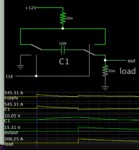kingtal0n
Junior Member level 3

Hello,
In the stores now we can buy such car battery voltage boosters as low as $20-$50
However they go bad over time. I want to learn how 'they' work, and find other methods to do the same thing.
So I can replace and maintain the system for years without buying magic boxes
There are no rules to this circuit complexity. I Don't mind generating AC with a hand or foot(bike)-crank through a rectifier feeding a series of capacitors to generate the electrical boost necessary to help an already mostly good battery. I have no idea if that would work (but I hope it would because its on my list to figure out)
My car has the battery in the rear, and a long "0" gauge cable to the starter. So it does start fine with a new battery, but the starting is slow as the sudden voltage drop at the starter creates a sort of 'lag' where the motor initially turns very slow and then speeds up. My goal is to remove this lag/delay by boosting voltage either at the battery or at the starter.
I have already considered the use of capacitors near the starter, and I think this is a very simple solution. Turn key, charge caps, start engine, disable caps. However I do not know how much capacitor I will need or if this is even a 'smart' idea.
Another idea is to use capacitors with a small "step up" from ebay, which takes 12v and turns it into say 16v. that way the capacitors which maybe a little too small get an extra bit of juice. 16v quickly becomes 10v when you turn the key, know what I am saying? It wouldn't sit that high for long. Right now I hit the key and 12.6v turns to 7.8v at the computer. So it must be 7v~ at the starter or less. Alot of current and very low voltage. Not good.
Another idea is to use some kind of oscillator with a coil or inductor to store energy in a magnetic field, coupled to capacitors, transistors, that stuff all together I know from looking at various curcuits could be used to boost voltage. Its beyond me technically but I am trying to work that direction anyways so this would be a good opportunity to try and salvage a used transformer or something and put it to work here.
So thats basically it for now: hand/foot crank idea, AC current oscillator + inductors&transistors®ulators, capacitors, caps + step-up booster, thats where I am at. Oh that and just buying a bigger battery lol
In the stores now we can buy such car battery voltage boosters as low as $20-$50
However they go bad over time. I want to learn how 'they' work, and find other methods to do the same thing.
So I can replace and maintain the system for years without buying magic boxes
There are no rules to this circuit complexity. I Don't mind generating AC with a hand or foot(bike)-crank through a rectifier feeding a series of capacitors to generate the electrical boost necessary to help an already mostly good battery. I have no idea if that would work (but I hope it would because its on my list to figure out)
My car has the battery in the rear, and a long "0" gauge cable to the starter. So it does start fine with a new battery, but the starting is slow as the sudden voltage drop at the starter creates a sort of 'lag' where the motor initially turns very slow and then speeds up. My goal is to remove this lag/delay by boosting voltage either at the battery or at the starter.
I have already considered the use of capacitors near the starter, and I think this is a very simple solution. Turn key, charge caps, start engine, disable caps. However I do not know how much capacitor I will need or if this is even a 'smart' idea.
Another idea is to use capacitors with a small "step up" from ebay, which takes 12v and turns it into say 16v. that way the capacitors which maybe a little too small get an extra bit of juice. 16v quickly becomes 10v when you turn the key, know what I am saying? It wouldn't sit that high for long. Right now I hit the key and 12.6v turns to 7.8v at the computer. So it must be 7v~ at the starter or less. Alot of current and very low voltage. Not good.
Another idea is to use some kind of oscillator with a coil or inductor to store energy in a magnetic field, coupled to capacitors, transistors, that stuff all together I know from looking at various curcuits could be used to boost voltage. Its beyond me technically but I am trying to work that direction anyways so this would be a good opportunity to try and salvage a used transformer or something and put it to work here.
So thats basically it for now: hand/foot crank idea, AC current oscillator + inductors&transistors®ulators, capacitors, caps + step-up booster, thats where I am at. Oh that and just buying a bigger battery lol




